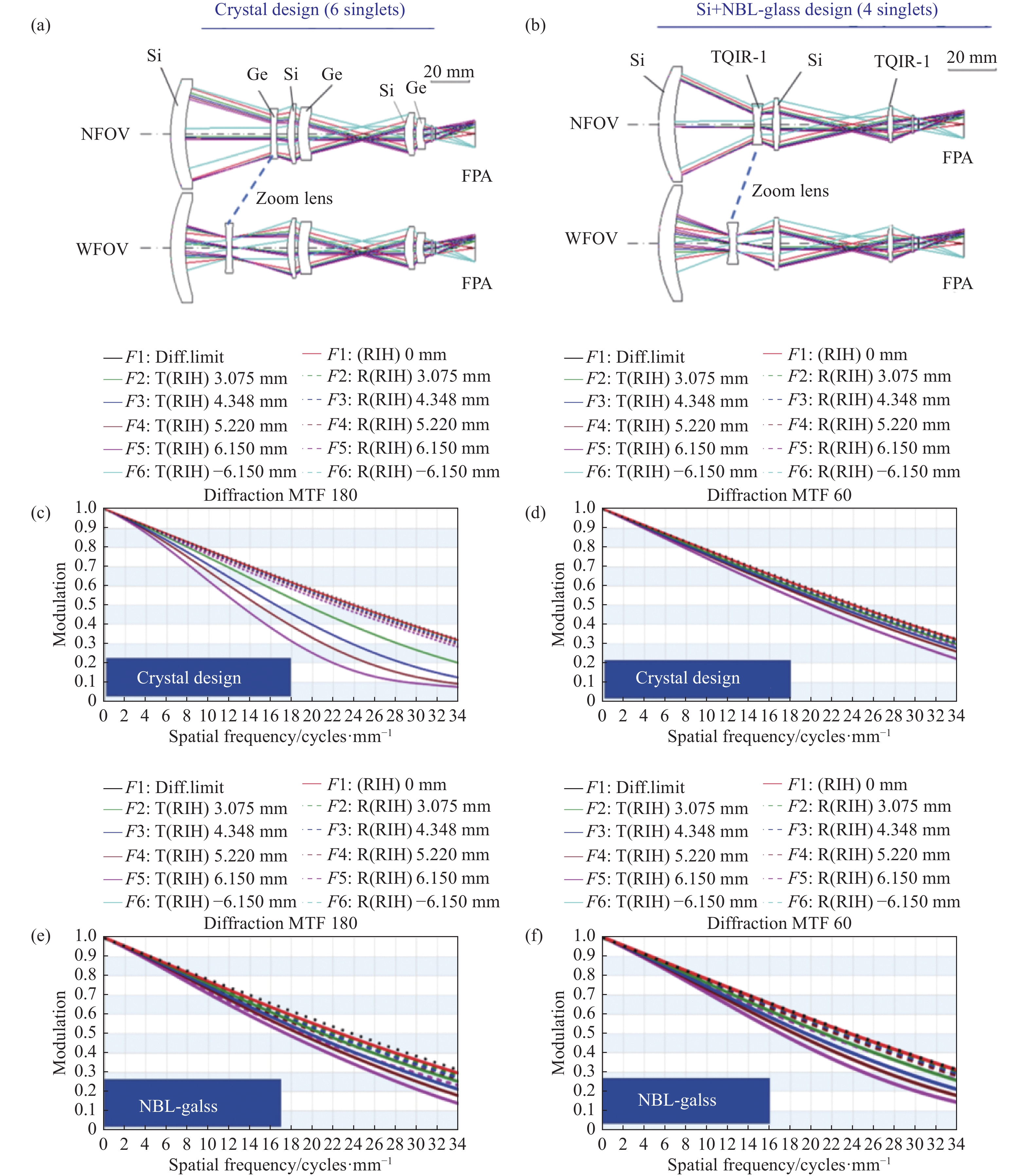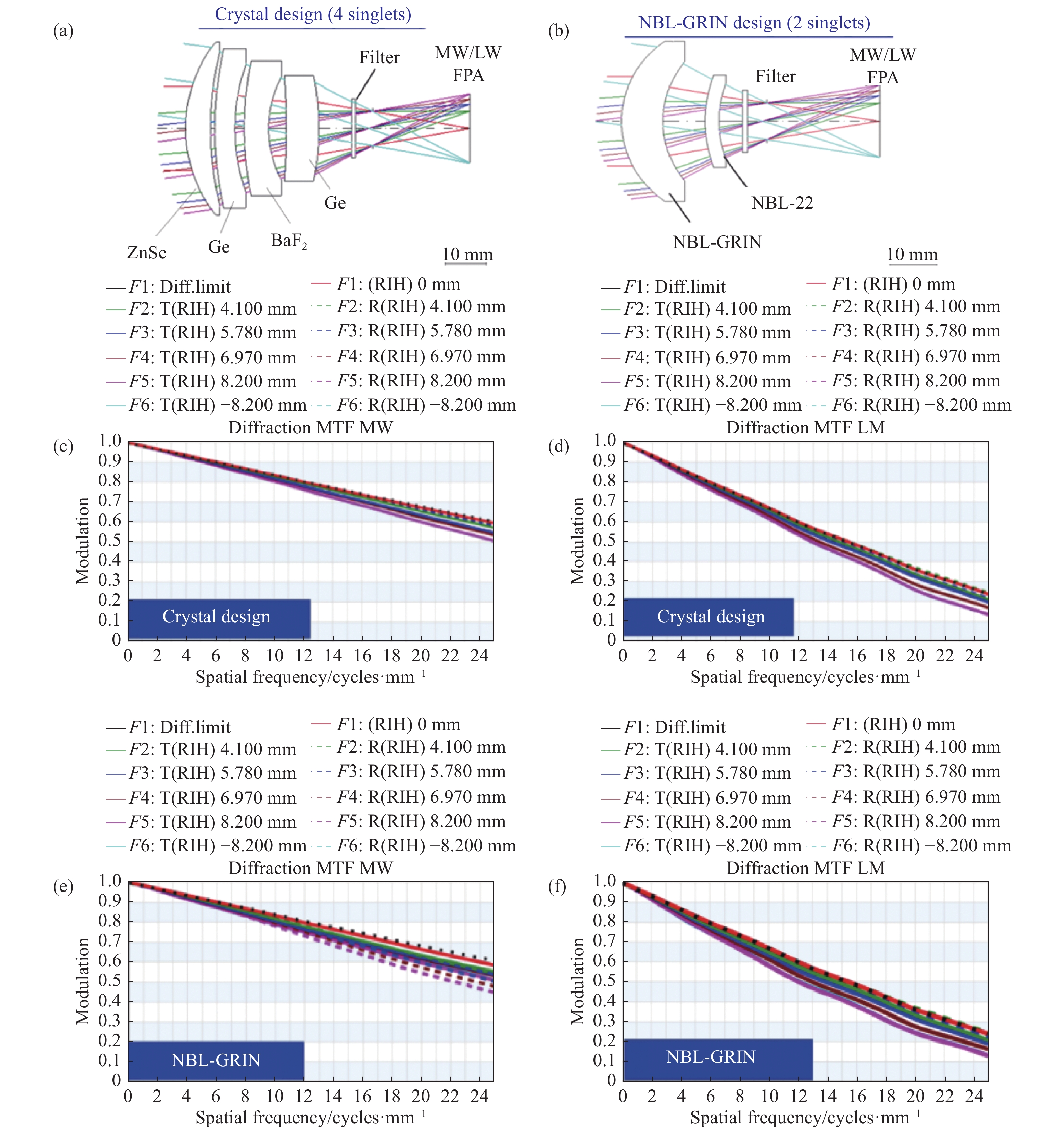-
红外热成像技术在当前国防军事领域具有不可替代的应用价值,它是红外警戒、搜索跟踪、精确制导等现代战争全天候作战的关键。为了满足各类高性能光电武器平台的兼容需求,红外光学系统的轻量化、小型化、低成本成为新一代红外成像系统综合性能评估的重要指标参数。实现新一代轻薄化红外光学系统的制造,迫切需要发展新型可制造的红外光学材料,为红外光学系统的设计提供更为丰富的材料选择和更多的设计自由度。
硫系玻璃与传统的红外晶体材料相比,其透射波段更宽(覆盖短波、中波和长波红外),并且折射率温度系数较低,折射率/色散参数选择丰富,化学稳定性较好,制备成本较低,近年来已经作为一种优良的红外光学透镜材料,被广泛应用于军用和民用领域的各类红外光学系统中,例如红外瞄准、体温测量、汽车夜视、安防监控等[1-8]。但硫系玻璃现有的应用主要是基于它的dn/dt系数较低这一特性,仅仅作为温度自适应红外光学系统中的消热差透镜被广泛认可,而硫系玻璃组分可调、色散参数选择较为丰富这两大核心优势并未得到进一步的充分开发和应用。与此同时,鉴于现有硫系玻璃与常用的硅单晶(Si)、锗单晶(Ge)材料相比较,其折射率较低,像差校正的效果不如上述Si、Ge两种材料,使得现有的硫系玻璃应用受限。
早在2008年,美国DARPA战略科技局就启动了M-GRIN计划(目前仍在进行中),以开发低成本、可定制化的新型硫系玻璃应用于各种军事系统,但仅限本国军用[9-10]。此外,日本也制备了可商用的高折射率硫系玻璃,但是价格昂贵,且供货周期较长。
文中针对新一代红外成像系统高性能、小型化、低成本的高度需求,通过研制系列化新型硫系玻璃,挖掘硫系玻璃组分可调这一优势,提高硫系玻璃折射率,进一步发挥其在红外光学系统中的像差校正能力;利用硫系玻璃丰富的色散特性,研制新型梯度折射率(gradient refractive index, GRIN)硫系玻璃,以充分发挥其在多/宽波段中的像差校正作用,满足我国新一代高性能光学系统的轻薄化设计需求。上述新型硫系玻璃的出现可以实现红外镜头的去锗化设计,大幅降低红外镜头的制造成本,具有广阔的商业前景。
-
目前所使用的传统红外材料,根据材料形式主要分为晶体材料和玻璃材料两大类,硫系玻璃由于具有良好的红外透射率和光学均匀性,目前成为红外玻璃材料的典型代表。常用的红外材料的透射波段和折射率如表1所示。
Material Transmission range/μm Refractive index @10 μm & 20 ℃ Si 1.2-10 3.4330 Ge 2.0-20 4.0030 ZnSe 0.5-15 2.4044 ZnS 0.4-12 2.1978 BaF2 0.8-10 1.4740 IG2 1-14 2.4982 IG3 1.2-14 2.7847 IG4 1-14 2.6099 IG5 1-14 2.6046 IG6 1-14 2.7793 Table 1. Refractive index and transmission range of general IR material
在透射式红外光学系统中,透镜材料的折射率越高,光学系统的光程越短,像差校正越容易,更易实现小型化的红外系统设计,这也是Si材料和Ge材料成为红外透镜中最常选用材料的主要原因。高折射率硫系玻璃可以在兼顾像差校正和镜头轻薄化设计的同时降低制造成本,是目前最值得开发的新型红外材料之一。
-
目前商用的硫系玻璃(IG系列)主要是由As-Se、Ge-As-Se或Ge-Sb-Se等硒基硫系玻璃组成,它们在波长10 µm处的折射率处于2.4~2.8之间。从表1中可以看出,硫系玻璃与常用的单晶Si、单晶Ge相比较,其折射率较低,不利于光学像差校正,使其应用受限。为了开发更高折射率的硫系玻璃,笔者在硫系玻璃的组分中引入具有更高极化率的重元素碲(Te),获得了折射率达到3.18(@10 μm)的新型高折射率硫系玻璃,其为实现低成本、轻薄型红外光学系统提供了全新的材料选择。
宁波大学红外材料与器件团队(NBL)最新研发的可制造、大尺寸的新型高折射率硫系玻璃NBL-TQIR-1,其组分为Ge-Se-Te。NBL-TQIR-1玻璃的透过光谱及样品照片如图1所示,该硫系玻璃在1.5-18 μm的超宽光谱范围内透明,并且可实现大口径(Φ≤100 mm)规模化制备,具体的材料性能参数详见表2。

Figure 1. Transmission spectra of high-index chalcogenide glass NBL-TQIR-1 (sample thickness of 2.5 mm). The photo of NBL-TQIR-1 chalcogenide glass sample with the diameter of Φ50-100 mm
Physical properties Density/g·cm−3 5.31 Glass transition temperature/℃ 178 Young’s modulus/GPa 25.53 Elastic modulus/GPa 9.80 Poisson’s ratio 0.30 Refractive index @ 20 ℃ Wavelength/μm n 2 3.26488 2.5 3.23436 3.7 3.20648 4.2 3.20124 4.8 3.19681 8 3.18531 10 3.18088 12 3.17620 Table 2. Physical properties of high-index chalcogenide glass
-
双/多波段共焦面红外探测器的出现使新一代成像系统的性能指标不再受限于探测器的灵敏度,而是受限于与之适配的光学成像系统的像差限制。反射式光学设计提供虽然解决了双/多波段成像光学系统的色差校正问题,但这类型光学系统带来的装配困难及环境适应性限制了其在复杂的军事环境中的应用,因此该类系统仍然寄希望于透射式红外光学系统。
现有的双/多波段透射式红外光学系统由于波段变宽,急剧提升了该类光学系统的色差校正难度,基于现有的红外材料要满足系统的性能要求,仍然需要多种材料组合才能完成像差校正,无法同时兼顾多/双波段共焦面成像与系统轻薄化的应用需求。
NBL团队开发的Te基系列化新型硫系玻璃,如表3所示,基于该系列化玻璃具有相似的玻璃转化温度(Tg)这一前提,并充分发挥硫系玻璃色散参数可选这一核心优势,可根据双/多波段红外成像系统的色差校正需求来选择双层、三层或多层Te基硫系玻璃,在真空或者惰性气体条件下,于Tg以上某一温度(玻璃软化温度Ts附近)处,对其进行加热保温后再进行加压,获得叠层式GRIN硫系透镜。
表3中列出了经过NBL团队研发、目前可制备的6种新型Te基硫系玻璃,根据光学系统的设计需求,采用其中任意两种或多种硫系玻璃进行组合,实现具有不同折射率差值Δn的GRIN硫系玻璃,以获得能够在双/宽波段成像系统中具有较强色差校正能力的GRIN硫系玻璃透镜。
Material λ-range
/μmRefractive index @ 20 ℃ Tg
/℃NBL-Te-2 1.5-14 2.4065 110 NBL-Te-7 1.5-14 2.4594 117 NBL-Te-12 1.5-14 2.5692 121 NBL-Te-17 1.5-14 2.5887 120 NBL-Te-22 1.5-14 2.6789 123 NBL-Te-27 1.5-14 2.8157 123 Table 3. Physical properties of Te-based serial new chalcogenide glasses
-
为了评估NBL开发的新型高折射率硫系玻璃透镜的潜在效益,针对最常用的中波制冷型640×512(F#4,@15 μm)红外探测器,在同一性能指标下,分别开展了基于传统晶体材料的中波双视场红外光学系统与基于NBL-TQIR-1硫系玻璃的中波双视场红外光学系统的方案设计,两种光学方案的设计结果如图2所示,性能对比结果如表4所示。
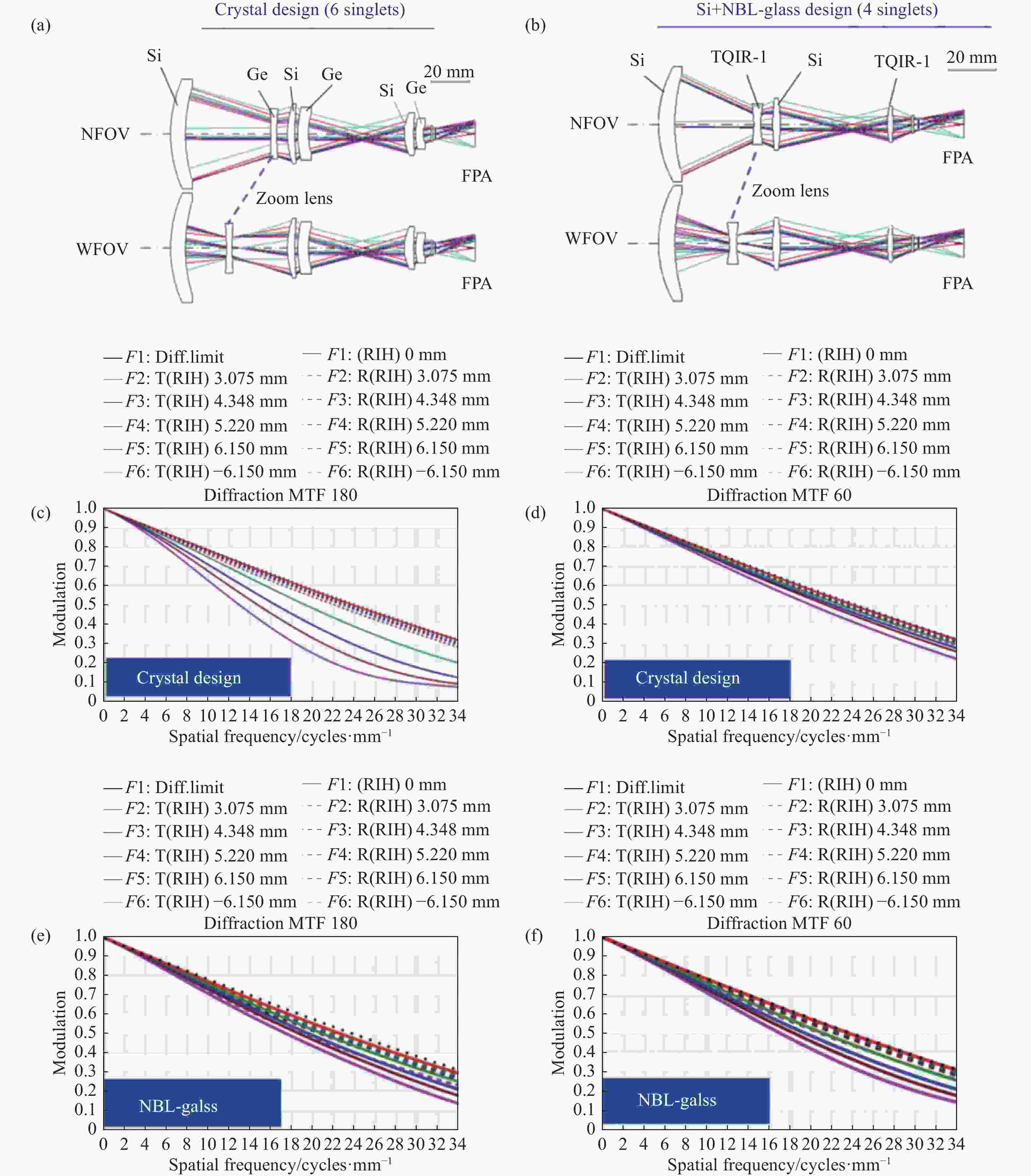
Figure 2. (a) Design scheme of dual-field MWIR optical system of traditional crystal materials, focal length of 60 mm, F#3; (b) Design scheme of lightweight medium wave dual-field optical system based on NBL-TQIR-1, focal length of 60 mm, F#3; MTF of traditional crystal materials optical system is calculated for (c) narrow field and (d) wide field; MTF of optical NBL-TQIR-1 system is calculated for (e) narrow field and (f) wide field
Characteristics Crystal design NBL glass design Spectrum/μm 3.7-4.8 FPA 640×512@15 μm F# 4 Focal/mm 180/60 Length/mm 150 130 Lens count 6 4 Aspheres 3 2 Mass-optical/g 70 45 Materials Si, Ge Si,
NBL-TQIR-1MTF
(nominal)20%@NFOV/
20%@WFOV10%@ NFOV/
20%@ WFOVTable 4. Comparison of performance indexes for medium wave dual-field optical systems
设计结果表明,在相同的性能指标下,两种光学系统的设计方案在特征频率(@33 lp/mm)处,两个视场下的光学传递函数MTF均贴近系统衍射限。由于新型高折射率硫系玻璃NBL-TQIR-1的折射率值达到了3.18(@10 μm波长处),对光学系统的像差校正起到关键作用,最终系统仅采用了2片单晶Si透镜与2片NBL-TQIR-1硫系玻璃透镜组合获得了性能优于采用传统晶体材料的光学系统的设计结果。与此同时,由于采用NBL-TQIR-1硫系玻璃替代了单晶Ge,使得新型光学系统比传统晶体材料光学系统透镜减少了2片,非球面减少1个,光学系统的质量减轻了35%,长度减少了15%,透过率提高了10%,有效实现了中波红外光学系统的轻薄化和低成本设计。
-
为了评估NBL开发的叠层GRIN硫系透镜在双波段红外光学系统中卓越的色差校正能力,分别针对非制冷型中/短波、制冷型中/长波共焦面双色探测器进行了光学系统设计。
-
针对非制冷型中/短波共焦面640×512(F#4,@12 μm)红外探测器,在同一性能指标下,分别开展了基于传统材料的中/短波红外光学系统与基于NBL-GRIN硫系玻璃的中/短波红外光学系统的方案设计,两种方案的设计结果如图3所示,性能对比结果如表5所示。这里需要说明的是,晶体设计中选用BaF2的原因是其相比于ZnS等具有更大的阿贝数,因此拥有更强的色差校正能力。
采用NBL开发的Te基新型硫系玻璃,在非制冷型中/短红外成像光学系统中首次实现了胶合透镜的设计,由于叠层GRIN硫系玻璃折射率差值Δn达到了0.25,充分发挥了GRIN硫系透镜在双波段光学系统中的色差校正作用,使得基于NBL-GRIN硫系玻璃的新型双波段光学系统仅采用2片新型硫系玻璃就完成了设计,比基于传统材料的光学系统透镜减少了2片,同时非球面减少1个,并去除了衍射面。在相同的性能指标要求下,新型光学系统质量减轻了40%,系统长度减少了30%,透过率提高了15%,前者光学传递函数MTF(@特征频率42 lp/mm)比后者提高10%,有效实现了共光路、共焦面双波段光学系统的紧凑型设计。
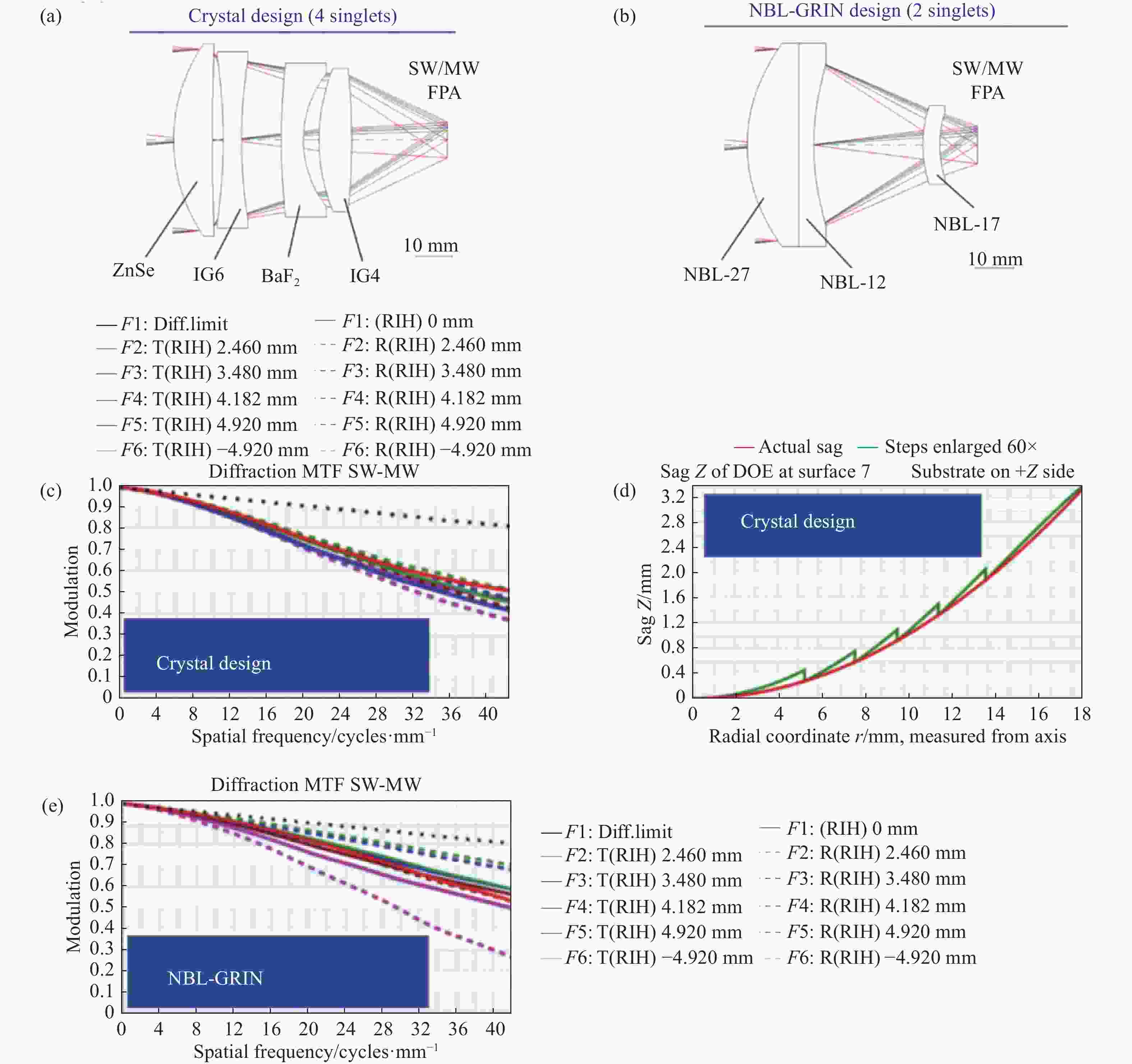
Figure 3. (a) Design of traditional material medium/short wave uncooled confocal optical system, focal length of 50 mm, F#1, from front to rear, ZnSe, IG6, BaF2, and IG4; (b) Design of medium/short wave cooled confocal surface optical system based on NBL-GRIN chalcogenide glass, 50 mm, F#1 lens, from front to rear, the two lenses are GRIN-NBL-27/NBL-12 and NBL-17, respectively; (c) MTF of traditional material medium/short wave optical system; (d) Sag Z diagram of the first diffractive surface of lens 4; (e) MTF of medium/short wave optical system
Characteristics Crystal design NBL-GRIN design Spectrum/μm 1.5-5 FPA 640×512@12 μm F# 1 Focal/mm 50 Length/mm 75 50 Lens count 4 2 Aspheres 3 2 DOE 1 0 Mass-optical/g 245 150 Materials ZnSe, IG6, BaF2 GRIN-NBL-27/12, NBL-17 MTF (nominal) 40% 50% Table 5. Comparison of common light path confocal surface SWIR-MWIR dual-band optical systems
-
针对制冷型中/长波共焦面红外探测器640×512(F#4,@20 μm)红外探测器,在同一性能指标下,开展了基于传统材料的中/长波红外成像光学系统与基于NBL-GRIN硫系玻璃的中/长波红外成像光学系统的设计,两种光学方案的设计结果如图4所示,性能对比结果如表6所示。

Figure 4. (a) Design of traditional material medium/long wave cooled confocal optical system, focal length of 60 mm, F#3, four lenses from front to rear, ZnSe, Ge, BaF2, and Ge; (b) Design of medium/long wave cooled confocal optical system based on NBL-GRIN chalcogenide glasses, focal length of 60 mm, F#3, the two lenses from front to rear are NBL-GRIN and NBL-22, respectively; MTF of traditional material is calculated for (c) MWIR and (d) LWIR wavebands; MTF based on NBL-GRIN is calculated for (e) MWIR and (f) LWIR
该系统设计中,基于NBL开发的Te基新型硫系玻璃制备的GRIN硫系透镜,其折射率差值Δn达到了0.3,在从中波到长波的较宽波段上充分发挥了GRIN透镜的色差校正作用。设计结果表明,NBL-GRIN硫系玻璃中/长波光学系统仅采用2片透镜就获得了性能与传统材料设计的光学系统性能相当的设计结果,但是NBL-GRIN光学系统在系统总长上比传统材料光学系统减少了20%,质量减轻了25%,透过率提升了18%。由于GRIN硫系玻璃双波段光学系统的透镜减少了2片,非球面减少2个,使得新系统的加工及装配成本都大幅下降。
Characteristics Crystal design NBL-GRIN design Spectrum/μm 3.7-4.8 & 7.7-9.5 FPA 640×512 @ 20 μm F# 3 Focal/mm 60 Length 70 55 Lens count 4 2 Aspheres 3 2 Mass-optical/g 110 87 Materials ZnSe, Ge, BaF2 GRIN-NBL-27/12, NBL-22 MTF (nominal) 45%@MWIR/
15%@LWIR45%@MWIR/
15%@LWIRTable 6. Comparison of common light path confocal surface MWIR/LWIR dual-band optical systems
-
新型硫系玻璃的出现是对现有红外材料的有益补充,为新一代透射式红外成像系统提供了更为丰富的材料选择和更多的设计自由度。
针对当前可用红外材料种类有限,现有硫系玻璃折射率相比晶体材料折射率较低的技术缺陷,利用硫系玻璃组分可调和色散参数可选两大特殊优势,开发了两类新型硫系玻璃材料。新型的高折射率硫系玻璃NBL-TQIR-1有效实现了中波红外成像系统的去锗化设计,在实现光学系统轻薄化设计的同时有效降低了红外光学系统的成本。新型叠层式GRIN硫系玻璃,在红外成像光学系统中首次实现了胶合透镜的设计,具有不同折射率差值Δn的GRIN硫系玻璃在宽波段成像系统中具有卓越的色差校正能力,为新一代共焦面宽波段红外成像系统的小型化设计提供了丰富的色散选择机会,是实现灵巧型双波段红外光学系统的重要技术途径。
为了满足新一代成像系统的工程化应用,基于新型硫系玻璃材料的制备工艺、透镜加工、表面处理及相关镀膜技术都将成为新一代红外成像光学系统不可或缺的技术支持。
Infrared imaging optical systems based on novel chalcogenide glasses (invited)
doi: 10.3788/IRLA20230102
- Received Date: 2023-02-28
- Rev Recd Date: 2023-04-08
- Publish Date: 2023-05-25
-
Key words:
- high refractive index /
- gradient refractive index (GRIN) /
- chalcogenide glass /
- dual-band /
- common path /
- infrared optical system
Abstract:



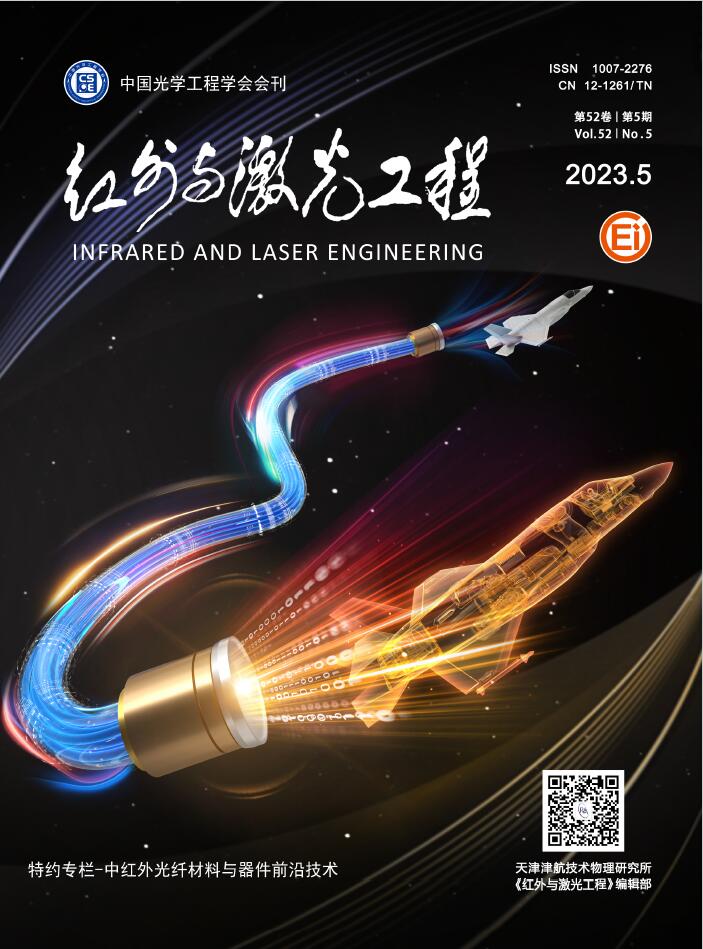


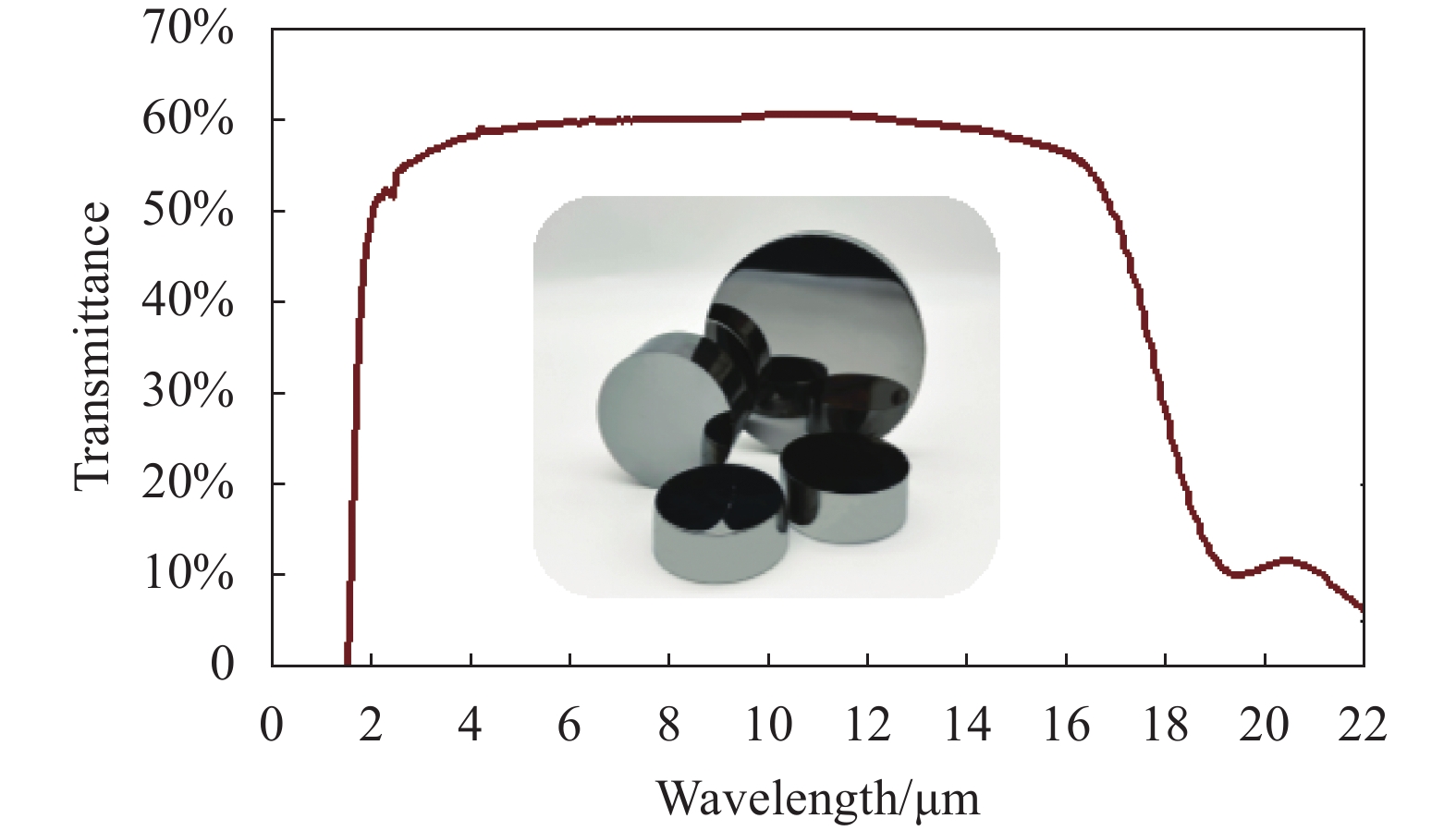



 DownLoad:
DownLoad:
